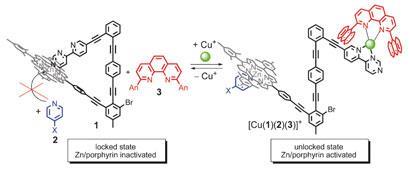A nanoswitch that can be turned on or off by copper(I) ions can be used to control an organic reaction
German researchers have created a molecular nanoswitch that can be reversibly and repeatedly turned on and off to control a chemical reaction. The work offers a way for creating molecular machines that can communicate with each other and control complex cascade reactions using a chemical switch.
Previously, a variety of molecular machines have been made that can change their state in response to external chemical, electrochemical and photochemical stimuli. In particular, self-locking mechanisms found in biology that control chemical reactions have inspired chemists to find ways of synthesising similar molecular switches.
While some advances have been made to create light activated molecular switches demonstrating clear cut on/off regulation of catalytic activity, using chemical stimuli has remained elusive.
Now, Michael Schmittel and colleagues at the University of Siegen in Germany have synthesised a nanoswitch that mimics the locking and unlocking mechanism of a protein kinase involved in brain function: calcium/calmodulin-dependent protein kinase II (CaMKII).

’If one looks closer, the complex machineries in our body are often highly sophisticated nanoswitches that communicate with each other,’ Schmittel says. ’For any reversible communication, however, both machines at the two ends of the communication line need to work reversibly in a highly reproducible manner.’
The team’s nanoswitch uses a simple but versatile architecture - a triangular molecule that can be locked (on) and unlocked (off) at one vertex. At this vertex two functional units meet - in the locked state they are chemically active. However, upon disconnection the molecule is no longer catalytically active.
The locking and unlocking mechanism rests on copper(I) ions, which when present unlock the molecule and turn off an organocatalytic reaction: the Knoevenagel reaction. Copper(I) has no direct interaction with the catalytic reaction - instead its presence causes the ’arm’ of a zinc porphyrin complex to swing out to chelate to copper(I) away from the zinc(II) cation in the porphyrin cavity. The zinc(II) centre, now free, binds and deactivates piperidine and the reaction stops. Removing the copper(I) turns the reaction back on.
’It’s a clever design which clearly works well and the catalytic activity can be switched on and off repeatedly,’ says David Leigh who investigates molecular machines at the University of Edinburgh, UK. ’Presumably it should be possible to bind and release chiral organocatalysts in a similar manner. I expect we’ll see rapid advances in the application of artificial molecular machines to chemical synthesis in the next few years.’
’Nanoswitches and communicating nanoswitches are the precursor stages to molecular robotics,’ says Schmittel. ’Using and extending the architecture along our general schematics will lead to a variety of nanoswitches to control other chemical reactions as well.’
James Urquhart
References
Angew. Chemie, Int. Ed., 2012, DOI: 10.1002/anie.201108089






No comments yet